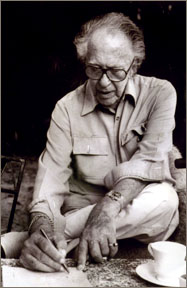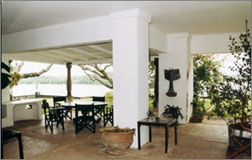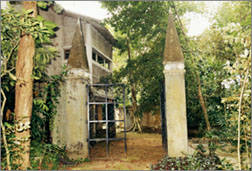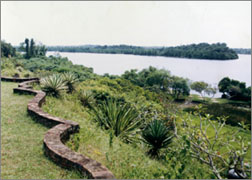|
observer |
|
|
|
|
|
OTHER LINKS |

|

|

|
|
Glimpse of History from ANCL Archives: Geoffrey Bawa - Legendary Architect and nature lover
Geoffrey Bawa (1919 - 2003) is considered as the founder of the tradition of tropical architecture and a unique style of architecture where life is celebrated in space and light. Bawa's colossal influence in shaping the form and motif of Sri Lankan architecture is well recognised and his work has had tremendous impact upon architecture throughout Asia and is acclaimed by a connoisseur of architecture worldwide. With his own approach to architecture, Bawa's tradition is unique which blends together the Western humanist tradition in architecture exotically with the lifestyle, climate, landscape and the traditions of Sri Lanka. Though he started late in his career at the age of 38, Bawa's creations over the last 25 years bear testimony to his intense devotion to the subject and tradition he moulded in considering the landscape, vegetation and the crucial setting for his architecture. His concerns for environment is manifested in sequencing of space, the creation of vistas, courtyards, and walkways, the use of materials and treatment of details. One of Bawa's earliest domestic buildings, a courtyard house built in Colombo for Ena De Silva in 1961, was the first to fuse elements of traditional Sinhalese domestic architecture with modern concepts of open planning, manifesting that an outdoor life is viable on a tight urban plot. The Bentota Beach Hotel of 1968 was Sri Lanka 's first purpose-built resort hotel. During the early 1970s a series of buildings for government departments developed ideas for the workplace in a tropical city, culminating in the State Mortgage Bank in Colombo hailed at the time as one of the world's first bio-climatic high-rises. Bawa also designed a holiday villa for the Jayawardene family in 1997 on the cliffs of Mirissa, which demonstrates Bawa's indefatigable inventiveness. Bawa was born in 1919 during the British Raj in ' Ceylon '. His father was a wealthy and successful lawyer, of Muslim and English parentage, while his mother was of mixed German, Scottish and Sinhalese descent. In 1938 he went to the University of Cambridge to read English, before studying law in London, where he was called to the Bar in 1944. Following World War II he joined a Colombo law firm, but he soon tired of the legal profession and in 1946 set off on two years of travel that took him through the Far East, across the United States and finally to Europe. In Italy he toyed with the idea of settling down permanently and resolved to buy a villa overlooking Lake Garda . He was now twenty-eight and had spent one-third of his life away from Ceylon. He was more European in outlook and had a loose-knit relationship with Ceylon. The plan to buy an Italian villa did not materialize, however, and in 1948 he returned to Ceylon where he bought an abandoned rubber estate at Lunuganga, on the south-west coast between Colombo and Galle. His dream was to create an Italian garden from a tropical wilderness, but he soon found that his ideas were compromised by a lack of technical knowledge. In 1951 he was apprenticed to H. H Reid, the sole surviving partner of the Colombo architectural practice Edwards, Reid and Begg. Following Reid's death suddenly, a year later Bawa returned to England. After spending a year at Cambridge, he enrolled as a student at the Architectural Association in London, where he is remembered as the tallest, oldest and most outspoken student of his generation. Bawa finally qualified as an architect in 1957 at the age of thirty-eight and returned to Ceylon to take over what was left of Reid's practice. He gathered together a group of talented young designers and artists who shared his growing interest in Ceylon 's forgotten architectural heritage, and his ambition to develop new ways of making and building. As well as his immediate office colleagues this group included the batik artist Ena de Silva, the designer Barbara Sansoni and the artist Laki Senanayake, all of whose work figures prominently in his buildings. He was joined in 1959 by Ulrik Plesner, a young Danish architect who brought with him an appreciation of Scandinavian design and detailing, a sense of professionalism and a curiosity about Sri Lanka 's building traditions. The duo formed a close friendship and a symbiotic working relationship that lasted until Plesner quit the practice in 1967 to return to Europe and Bawa was joined by the engineer K. Poologasundram, who remained his partner for the next twenty years. Bawa's growing prestige was recognized in 1979, when he was invited by President Jayawardene to design Sri Lanka 's new Parliament at Kotte, 8 kilometres east of Colombo . At Bawa's suggestion the swampy site was dredged to create an island at the centre of a vast artificial lake, with the Parliament building appearing as an asymmetric composition of copper roofs floating above a series of terraces rising out of the water. Abstract references to traditional Sri Lankan and South Indian architecture were incorporated within a Modernist framework to create a powerful image of democracy, cultural harmony, continuity and progress and a sense of gentle monumentality. During the 1980s Bawa also designed the new Ruhunu University near Matara, a project that enabled him to demonstrate his mastery of external space and the integration of buildings in a landscape. The result is a matrix of pavillions and courtyards, arranged with careful casualness and a strong sense of theatre across a pair of rocky hills overlooking the southern ocean. These projects brought Bawa international recognition and his work was celebrated in a Mimar monograph by Brian Brace Taylor and in a London exhibition. A later book by Christopher Bon on Lunuganga served both as a personal tribute to a friend and a beautiful photographic evocation of a garden. But the Parliament building and Ruhunu had left Bawa exhausted and at the end of the 1980s he withdrew from his partnership with Poologasundram and relinquished the name Edwards, Reid and Begg. He was now seventy and it was widely assumed that he would retire to Lunuganga and contemplate his garden. However, the break signalled a fresh round of creative activity and he began to work from his home in Bagatelle Road , Colombo , with a small group of young architects. Together they embarked on a stream of ambitious designs - hotels on Bali and Bintan, houses in Delhi and Ahmedabad, and a Cloud Centre for Singapore. None of these was built but each created enormous amounts of ideas. Some of these ideas came to fruition in three hotels built in Sri Lanka in the 1990s: the Kandalama, conceived as an austere jungle palace, snaking around a rocky outcrop on the edge of an ancient tank in the Dry Zone; the Lighthouse at Galle, defying the southern oceans from its boulder-strewn headland; and the Blue Water, a cool pleasure pavillion set within a sedate coconut grove on the edge of Colombo. In 1998 Bawa was tragically struck down by a massive stroke that left him paralysed and unable to speak. A small group of colleagues, led by Channa Daswatte, have continued to work on the projects he initiated before his illness - an official residence for the President, a house in Bombay , a hotel in Panadura - with drawings being taken down the corridor from the office to Bawa's bedroom for nods of approval or rejection. He died in 2003.Bawa won Sri Lankan and International awards including the national honour of Deshamanya from the Government of Sri Lanka in 1993 and the Aga Khan Award for Architecture Chairman's Award in 2001. |




















